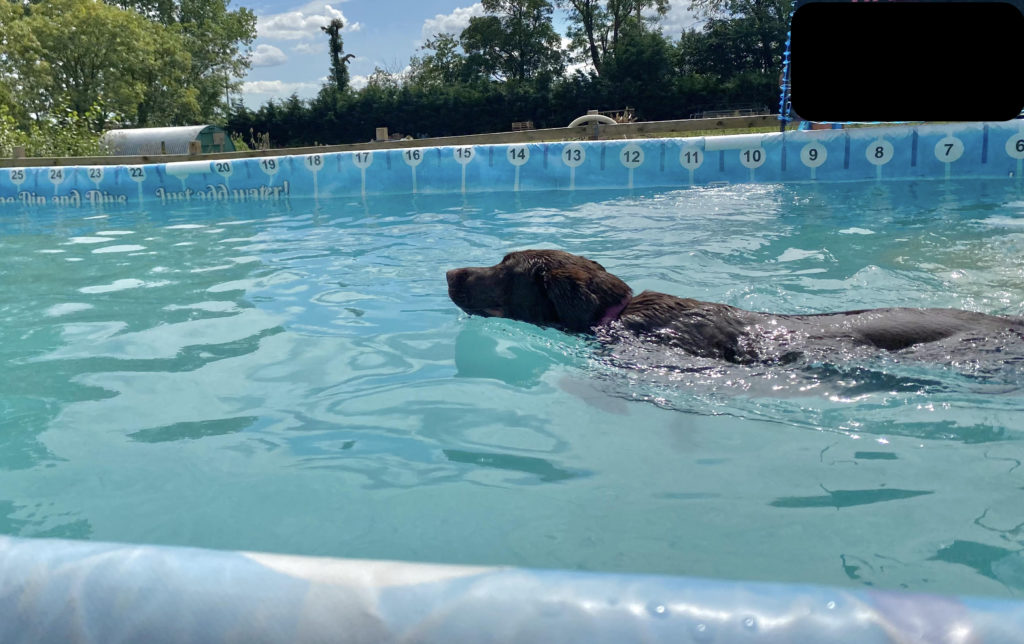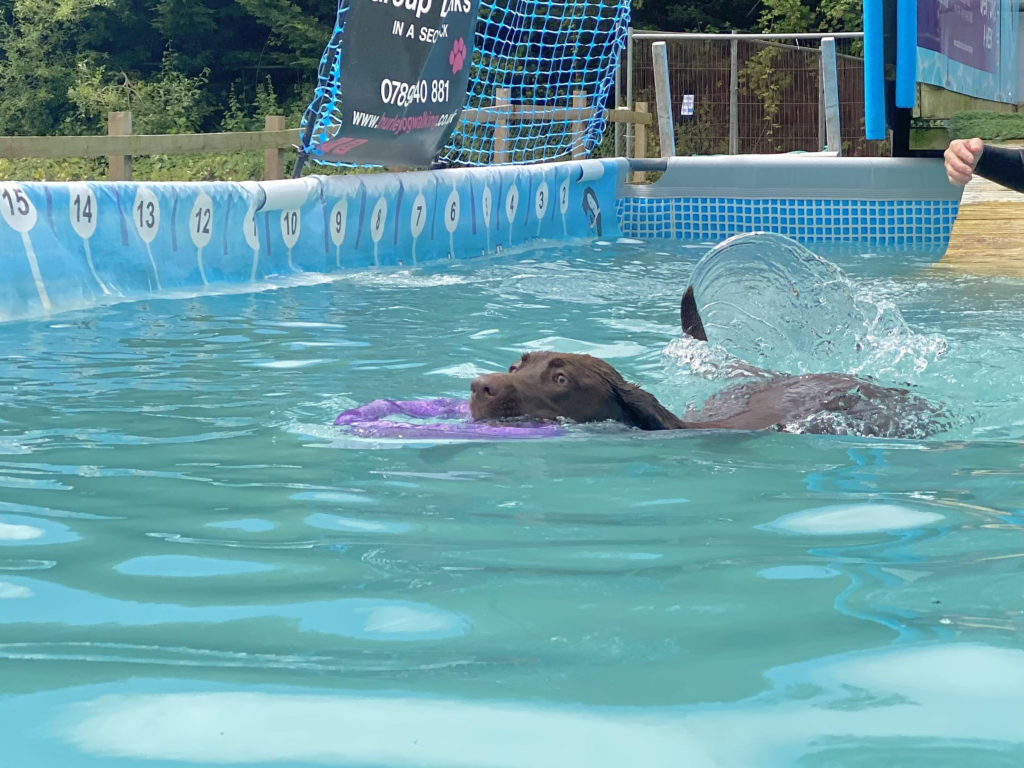
Dogs can often swim naturally, while some try to avoid water at all costs like my Norwich Terriers! Swimming for dogs or with our dogs is becoming more and more popular as a recreational activity and not just for physio via a vet’s referral.
As a Certified Professional Canine Fitness Trainer who also has taken my own dogs to hydrotherapy and for fun swimming sessions I have researched swimming as an activity for dogs for several years, in fact over 10 years! I am not a certified hydrotherapist, but am very interested in understanding how swimming benefits and affects our dogs.
Benefits of taking your Dog Swimming –
🐕 It can be fun for dogs of all kinds of activity levels if they like water and getting wet. Dogs can even enjoy swimming with their owners which can be hugely rewarding for both dog and owner; eg Swimming, paddling, splashing about, fetching floating toys etc! As an activity to do with your dog it can be a way to spend time together, as well as motivation for a dog who can no longer have long walks, runs etc.
🐕 Swimming can be a really nice way for dogs to receive some exercise during warmer months without over heating. Many dogs take a long time before noticing the rising temperatures over the summer and so are still needing to use their energy rather than trying to keep cool, and swimming / paddling can help use up the excess energy without making dogs hotter from running etc. One important note from having seen many people use a dog paddling pool in their gardens online; Try to ensure the area with the water is shaded so it’s not counter productive and encouraging your dog to play in water but in the full sun! Dogs can experience sunburn, sunstroke and heatstroke so stay on the side of caution.
🐕 Swimming can help strengthen the body for dogs without specific joint issues. Swimming, paddling, wading through water all provide resistance which in turn helps with strengthening as well as cardiovascular exercise. Taking your dog on your own for swimming can help keep their body fit and strong, however do also be aware that swimming without a hydrotherapy professional to help work on known issues may mean the rear legs, the hips etc are not being worked as dogs tend to pull themselves forwards with the front end and not use the rear legs properly, or turn by using momentum instead of using the tail, legs etc.
🐕 Swimming or even just floating in water can be a welcome break for dogs with joint or muscular discomfort, including arthritis, who may tire very fast from a general walk. In fact there are dogs who have hydro sessions to just float in the water and enjoy the relief on their bodies!
🐕 Swimming can be free – you don’t have to book a dog swimming pool but can use some natural bodies of water if you know they are safe lakes. Do be careful of Blue Water Algae which can be present in water like lakes and ponds – check with people in the area to find safe places for dogs. This can make swimming cost effective and very accessible for most dogs, plus there are lots of different types of dog pools available now so it is possible to chill in your garden in a dog pool with your dog without most than an initial outlay – and there are many pools available for a fraction of a price second hand too.
🐕 Dogs who are overweight can find being in water a nice way to take the additional strain from their bodies. They may swim or float so do check they have a well fitting and non restrictive dog life jacket on. The swimming or walking through even shallow water can be helpful with getting the body working which in turn can help with weight reduction alongside reducing their food etc. Do ensure you seek help from your Vet, a Dog Professional who can help with the exercise or a Canine Nutritionist to help with meal sizes.
So there are quite a few benefits to taking our dogs swimming!

What to be aware of –
Don’t be fooled into believing it’s a miracle cure for all canine health issues! Although it can be extremely beneficial for many dogs with joint, muscular or ligament issues or to prevent issues by strengthening the body in advance, there are some issues that can be made worse from swimming so it’s always advisable to seek advice from a canine professional, such as a vet, physio or conditioning instructor, before starting to take your dog swimming. When starting official hydrotherapy or underwater treadmill dogs won’t spend the whole session in the water working! Instead they will warm up, have a short time in the water then time to rest rather than a solid block of swimming for 5-10 mins which can easily happen when taking our dogs to a pool or stream. It is possible for dogs to experience over activity or exhaustion by doing too much even when there isn’t a known joint issue that might be affected.
❗️For example, the illiopsoas area along the inner thigh can be damaged through activity and take a long time to heal. Swimming puts a lot of pressure on this area and can cause damage rather than healing if an owner doesn’t know what movements, timescales etc should be used.
There are other health issues that can start as a result to swimming, without a health issue being there to begin with:
❗️Swimmer’s Tail is a condition where after a dog has been swimming in any temperature water the tail becomes limp, but is more commonly seen in cooler water. It can also occur after excess activity and exercise out of the water but is more noticable after swimming and is overuse of the muscles which become strained and can cause no only the tail to hang limp but can also be painful for the dog and even affect balance too. Ensuring that you dry your dog’s lower back and all around the tail straight after swimming can help reduce the risk of Swimmer’s tail but it can still happen especially when the limp tail is a symptom of something else happening in their body.
❗️I’d also like to mention water intoxication; which is when dogs ingest large amounts of water in a short time. Basically the body cleverly stores sodium to ensure the body stays within safe levels but when dog’s ingest large amounts of water quickly the body cannot store the sodium quickly enough so it tries to help the body by storing it in any cells it can find which can include brain cells – not usually intended for Sodium!! Dogs may take in additional water when retrieving lots of toys while in the water, diving to get a toy, or they like to gulp the water to drink while swimming. They may bring up the water very soon after or they may not. Water intoxication may not show for days or even for a week or two but then you may see signs your dog is in distress such as drooling more, bloated belly, vomiting, and lethargic. This is known as hyponatremia or even ‘dry drowning’ as dogs may not be near any water when symptoms start to show. Not playing fetch in the water, encouraging your dog to dive or spraying the hose pipe into your dog’s mouth are ways of reducing the risk.
❗️If your dog has long drop down ears (eg Labrador or Spaniel style) check them after swimming and dry them as best you can inside to prevent infections. Wet ears can be a breeding area with moist, warm skin mostly uninterrupted!!
Why it might not suit every dog –
Dogs with specific issues (as mentioned in the Swim Article)may not benefit from swimming at all, and in many cases swimming could make the issue worse. This also includes dogs with IVDD (Intervertebral Disc Disease) or spondylosis.
Hip Dysplasia can be an issue where swimming is advised to help strengthen but when dogs swim they tend to use their front legs to pull themselves through the water rather than driving with the back legs. This means the rear end isn’t being used and therefore isn’t being strengthened! Swimming with a hydrotherapist will help encourage your dog to use all the body which will start helping strengthen the weaker areas.
The shape of your dog may determine how well they swim!! Dogs with longer backs, shorter necks, deeper chests etc may find swimming a little harder and benefit from shallow water or the use of a dog life jacket.
Where dogs can try swimming –
Introducing to water to paddle, walk or play can start in the garden in a paddling pool, large bowl of water such as washing up bowl or even your pond if shallow and not too full with plants etc! You can also try shallow areas on walks where your dog can use the natural slope into the water or puddles at the beach when the tide has gone out.
If they are enjoying water there are lots of places now that you can take your dog to for supervised introductions to swimming. We took our Chocolate Labrador to a doggie swimming pool last summer as she loves water; she really wasn’t sure about the ramp or deeper water but with encouragement from us all plus us getting in the water she was soon taking herself in for a swim and knew where to get out via the ramps. Having the controlled environment plus plenty of people to help meant lower risk and more fun for Aero! She tries again this August and after an initial introduction to the ramp and water remembered the fun she had had and was swimming happily in no time!
Many lakes and streams will allow dogs in during your walks; try and find areas of water with sloping banks or shallow points do your dog can get out easily as if they swim until they feel tired then discover they have to pull themselves up onto the bank they may panic which won’t help them in the water!
There is also the option of the sea! Please be mindful of tide changes, under currents and how deep the sea can suddenly become as it can be all too easy for an inexperienced dog to be taken further out than expected. Again salt water can be very problematic for dogs so shorter time in the Sea would be advised and less time with a toy to hold too.
You can of course have your dog in a harness or floatation jacket with a long line attached to help your dog stay within your reach but check the area your dog is swimming doesn’t have lots of trees along the bank for the line to be caught in!
There are now even enclosed dog walking fields that have been designed to look like a private beach with a pool the dogs can use. This provides a nice way to introduce your dog to being in water without the distractions of other dogs or people and with time for you to help! We are in the Essex and Suffolk area of the UK and Suffolk has a secure dog area called The Cove which is basically your dog’s private beach area! It has a lovely water area with jetty and stone beach, steps up to the grass area and even a little summerhouse to relax in.
My favourite way for dogs to spend time in the water is to take them Paddleboarding or in the Inflatable Canoe with me. They can start off with me then if it’s safe for them to swim I can I clip their lead and let them know it’s ok to get in the water. You might want to practise helping your dog get back on – either directly on the board or in the canoe or teach your dog to get on the bank and wait for you to come close enough that they can jump back on!
Using a doggie life jacket while swimming can help dogs to feel supported plus they often have a handle which can be used to support your dog while getting in or out of water or if they show signs of fatigue during swimming. These can help a dog new to swimming or a dog with breathing issues.
Be aware of giving your dog rests, especially when they first try being in water, and although you want to have fun try to consider how to keep your dog safe too!
Have you taken your dog swimming or do they swim with you? We would love to hear about it – where do you take them?
This blog was inspired by my article inclusion in Swim Magazine Summer 2023 for a piece about swimming with your dogs. The article focused more on owners and dogs swimming together but this blog looks more at dogs going swimming with their owners watching. You can purchase the Swim Magazine with the full multiple page article here: https://pocketmags.com/swim-magazine?gclid=CjwKCAjw_uGmBhBREiwAeOfsdwKZ3PlXEQLPHoOE0U2yBgUSCtapuhrhdyZcZQfJBw_m1PUAWFrroxoCDSQQAvD_BwE&gclsrc=aw.ds

We’ve got little bags of pumpkins seeds when do our supermarket shopping at other times of the year and use…
Thank you Joe. Very good idea, particularly as pumpkins are so widely available at this time of the year. Will…
Blog suggestion:
Try New Activities with your Dog!
- Take a look at our Blog talking about various activities you might like to try with your dog that we run throughout the year
Blog suggestion:
Entertaining our Dogs on Hot Days!
- If you enjoyed reading about swimming with your dog you might also enjoy some tips on how to entertain your dog on hotter days!
Blog suggestion::
Socialisation for Dogs of all ages!
- Socialisation isn’t just for young puppies but is for all dogs and can continue throughout dogs’ lives! Our Blog includes our talk on The Dogs’ Frolics radio show and the link is in the blog post – take a listen and see if you wind something to try with your dog today!




HiyaJoe. Just bought a huge pumpkin and know I need to dry out the seeds but do I cook the…